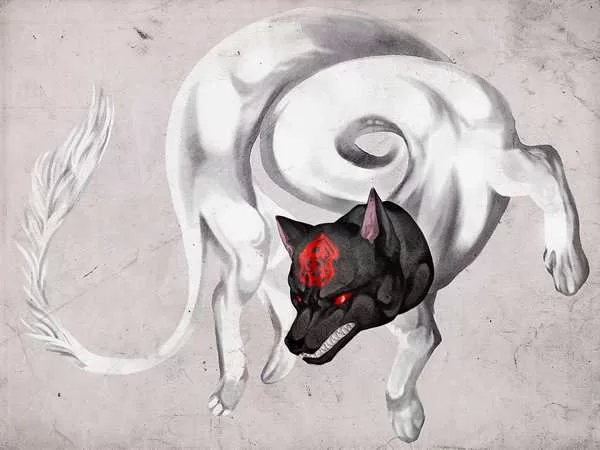In the late 1930s, the island of Kaua’i faced an unsettling phenomenon. Known as ‘Inu-gami sawarimono,’ this mysterious affliction involved a dog spirit purportedly possessing individuals and causing them harm. This unsettling chapter in Kaua’i’s history would resurface before World War II, blending folklore with real-life encounters in ways that continue to fascinate and terrify.
The Enigmatic Inu-gami: Possession and Supernatural Influences
The term “Inugami” translates to “dog spirit” in Japanese, and its lore encompasses a range of unsettling behaviors. Originating from Japan, the Inugami was believed to possess individuals, particularly those who were emotionally or psychologically vulnerable. This malevolent spirit’s impact was not only felt in Japan but also made its way to Hawaii, where it left a mark on local folklore.
In 1994, Glen Grant, a renowned historian, explored this chilling phenomenon in his book, Obake: Ghost Stories In Hawai’i. The narrative centers on a young Japanese girl named Dawn, who falls off the social grid and begins exhibiting peculiar traits associated with a dog. As the story unfolds, it becomes clear that Dawn is possessed by the Inugami. The climax of this harrowing tale sees her transform into a monstrous figure with canine features, attacking the author himself.
Grant’s unsettling encounter with Dawn was not the end. Twelve years later, during a lunch meeting, he would recognize her only when she removed her sunglasses. The horror did not end there; she attempted to kill Grant again, this time with a pair of sharp scissors. Grant, overwhelmed by retaliatory rage, felt momentarily possessed by the Inugami, leading to an intriguing yet frightening exploration of supernatural influences on human behavior.
Historical Roots and Cultural Implications
The Inugami’s story is deeply rooted in Japanese folklore. Traditionally, the Inugami falls under the category of tsukimono, possession spirits known to afflict those with emotional and psychological instability. This practice was once so feared that families known for Inugami rituals, particularly in Hiroshima, kept mummified dog heads to unleash their malevolent spirits on others. Such practices were illegal and could lead to severe punishments, including death.
In Hawaii, this concept found new ground. The 1978 book, Kodomo No Tame Ni, authored by Dennis Ogawa and Glen Grant, recounts Senator Spark Matsunaga’s experiences with Inugami. Matsunaga’s father, an Ikibotoke (living saint), treated numerous victims of dog spirit possession. The senator’s planned publication on his father’s exorcisms remains unpublished due to his untimely death, leaving a significant gap in understanding the full scope of Inugami’s impact.
The Inugami’s Path: From Myth to Modern Experience
One of the fascinating aspects of Inugami lore is its method of possession. It is believed that the Inugami can enter a victim through their ears, particularly if they are already psychologically distressed. This peculiar detail adds another layer to the lore, suggesting that protective measures like earplugs might offer some respite from these supernatural influences.
In contrast, Hawaiian legends often portray dogs in a more benevolent light. Dogs in Hawaiian folklore are often seen as Kupua, demi-gods who assist humans in times of need. For example, Kaupe, a cannibalistic dog-god, was known for his appetite for human flesh but ultimately was defeated by the great Mo’o Kahuna Kahilona. On the other hand, Puapualenalena, a renowned dog hero, was celebrated for his intelligence and bravery, retrieving a sacred conch shell for his master, Chief Kiha.
Despite the rich tapestry of Hawaiian dog legends, there is no recorded instance of a Hawaiian or local person being possessed by a dog spirit akin to the Inugami. Hawaiian spirituality does involve interactions with spirits, such as the Noho, where a family’s deceased guardian communicates through a living medium. However, Inugami possession appears to remain distinct from Hawaiian spiritual practices.
Cultural Crossroads: The Intersection of Hawaiian and Japanese Folklore
Hawai’i’s multicultural heritage, influenced by diverse immigrant communities, has created a unique cultural mosaic. The plantation culture, shaped by immigrants from various parts of the world, blended traditions, superstitions, and beliefs. This cultural exchange contributed to a rich tapestry of folklore that includes elements like the Inugami.
While the Inugami’s presence in Hawaii is primarily a product of Japanese folklore, its integration into the broader cultural context reflects the ongoing exchange of traditions among different communities. As such, the haunting legacy of the Inugami serves as a fascinating example of how folklore evolves and intermingles in new cultural environments.
Conclusion
The story of the Inugami offers a chilling glimpse into the intersection of folklore, personal experience, and cultural heritage. From its origins in Japanese superstition to its unsettling appearances in modern Hawaii, the Inugami’s legacy continues to captivate and mystify. As folklore evolves and intertwines with contemporary experiences, it underscores the enduring power of cultural narratives to shape our understanding of the world.
Whether viewed through the lens of historical accounts or personal encounters, the tale of the Inugami remains a powerful reminder of the supernatural forces that continue to influence our lives and beliefs.

